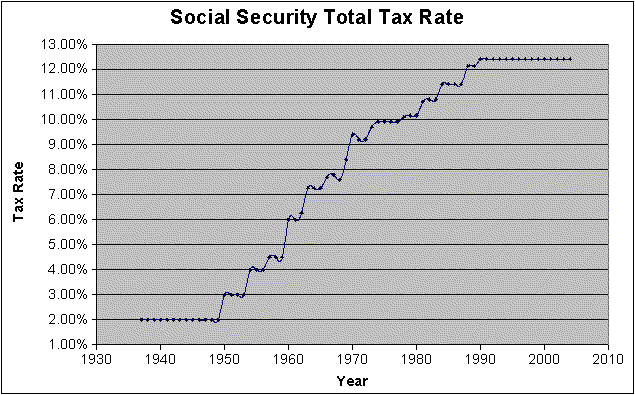Richard "Jay" Edgar
Libertarian Candidate for 4th District US Congress
Reform of Social Security
Social security is a rip-off for all Americans. Our current social security tax rate is 12.4%. You have 6.2% taken from you each pay period, your employer is forced to contribute another 6.2%.
Ronald Reagan made a big splash into national politics on October 27th, 1964 with his stump speech for Barry Goldwater's presidency. In this speech he noted:
- "A young man, 21 years of age, working at an average salary...his Social Security contribution would, in the open market, buy him an insurance policy that would guarantee $220 a month at age 65. The government promises $127. He could live it up until he is 31 and then take out a policy that would pay more than Social Security. "
Since then things have gotten much worse. In 1964 the total social security tax rate was only 3.625% and you got full benefits at age 65. Now the rate is 12.4% and you can't collect full benefits until you are 67 (note that the rate increased from 10.16% to 12.12% during Reagan's tenure)1. If a young man, working at an today's average salary were to invest his Social Insecurity contribution in the open market by the time he was 65 he would be able to withdraw $4,156 per month until he is 80.2 (assuming an interest rate of 6%3). If his employers contribution is added to his savings he would have a very comfortable retirement. The government now promises $1320, and this is only true if he waits to start collecting until he's 67. Using just his contribution, he could live it up until he is 37, and then start investing and still end up with a nest egg bigger than what he would get with social security.
Note that the current expected life span for a male in the US is 70 years. At today's average salary a persons direct contributions over a 40 year period would total $89,704.80. (this only takes into account his contributions, it ignores all of the compounded interest that would have accumulated if he/she was able to save this money himself) If he/she were to die at the age of 70, he/she only would have collected $47,520 of their contribution. If he/she was able to have saved this money in a private account the heirs would inherit the savings. Under social security only a surviving spouse (over the age of 65 for full benefits) and/or a child under the age of 18 (older for some disabled children) can receive any of the meager benefits provided by Social Insecurity.
The solution is to allow citizens the choice of what to do with their own money. Our current Social Security system must be eliminated. We can not wait! Something must be done now. I don't want my children forced to support me in my old age. I propose a plan where we phase Social Security contributions into private accounts over a 10 year time period, while protecting current retiree benefits.Notes and References
1. Social Security tax rate history. Note the words "employee and employers, each" in the table. To get the true rate of taxation, you must double the amounts shown.

2. Bureau of Labor Statistics reports the average annual wages in the U.S. as $36,764 for 2002. At current rate of taxation employers average monthly share is $189.95. The employee matches this for a total average monthly share of $379.89 Saving $189.95 per month at an annual interest rate of 6% for 44 years would result in a savings of $490,881. This would allow withdrawals of $4,156.63 per month for fifteen years.
3. I arbitrarily chose 6% as a medium value between different investments. Historically over the period from 1926 to 1996 annual returns for various investments have yielded:
- small stocks 12.5%
- Real Estate 11.1%
- DJI 10.0%
- Bonds 5.2%
- T-Bills 3.7%
Paid for by Edgar For Congress